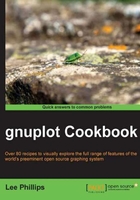
What this book covers
Chapter 1, Plotting Curves, Boxes, Points, and more, covers the basic usage of Gnuplot: how to make all kinds of 2D plots for statistics, modeling, finance, science, and more.
Chapter 2, Annotating with Labels and Legends, explains how to add labels, arrows, and mathematical text to our plots.
Chapter 3, Applying Colors and Styles, covers the basics of colors and styles in gnuplot, plus transparency, and plotting with points and objects.
Chapter 4, Controlling Your Tics, will show you how to get your tic marks and labels just right, along with gnuplot's new internationalization features.
Chapter 5, Combining Multiple Plots, shows how to arrange a set of graphs on the page, and make inset plots.
Chapter 6, Including Plots in Documents, delves into incorporating your plots into technical documents, presentations, and web pages.
Chapter 7, Programming gnuplot and dealing with data, covers how to use gnuplot's built-in programming constructs as well as its ability to be used from any programming language, and how to use the new volatile data features.
Chapter 8, The Third Dimension, shows how to plot surfaces, vectors, heat maps, and lines in a 3D space.
Chapter 9, Using and Making Graphical User Interfaces, introduces several GUIs for gnuplot and includes writing a web application with gnuplot on the backend.
Chapter 10, Surveying Special Topics, covers several special techniques and applications: mapping; labeled contours; colored and broken axes; pictures; and more.
Appendix, Finding help and information, provides a brief list of sources of gnuplot information and education.